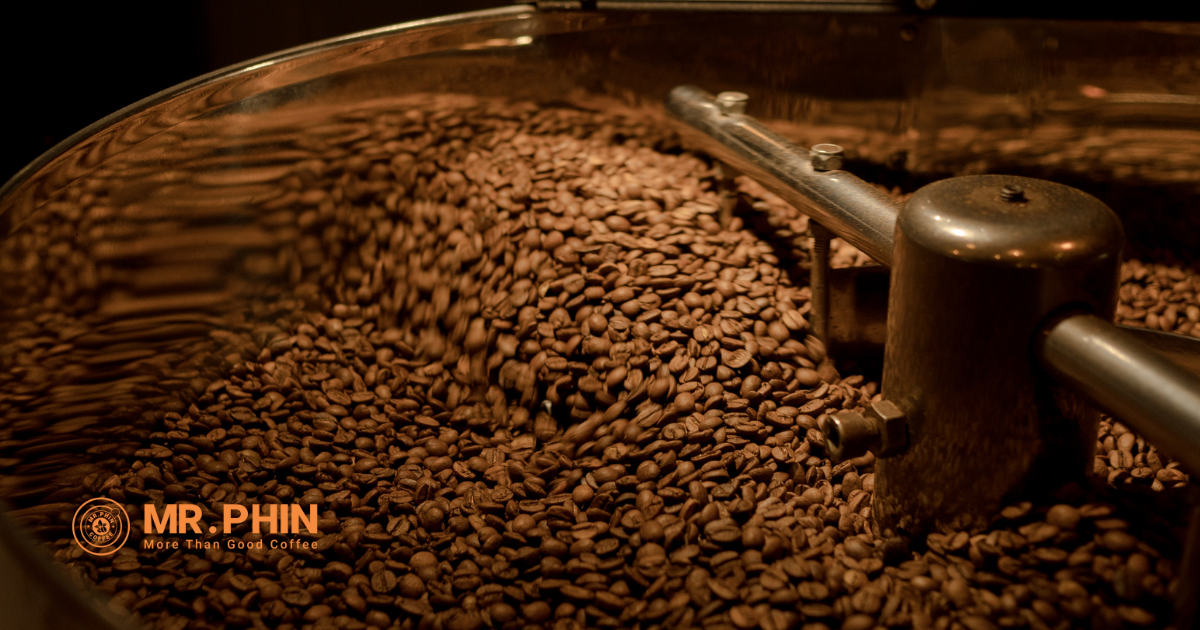Explore the 4 levels of coffee roasting and other basics
Coffee is one of the most beloved beverages around the world. However, to enjoy a truly flavorful cup of coffee, the beans must first be properly roasted. Currently, there are four widely adopted coffee roasting levels, each influencing the flavor profile in unique ways.
In this article, Phương Vy Coffee will help you understand why coffee needs to be roasted and provide insights into the taste characteristics of each roast level.

1. Why Do Coffee Beans Need to Be Roasted?
Roasting is a key step that brings out the aroma and unlocks the hidden flavors inside each coffee bean. Different roasting techniques deliver distinctive flavor nuances, making every bean unique. A high-quality cup of coffee depends on a carefully executed roasting process.
Roasting involves applying heat to trigger chemical reactions within the bean. Once the coffee beans reach their optimal state, they undergo a cooling phase to complete the roast. Roasted beans are aromatic, flavorful, and exhibit a dry, crisp texture—perfectly ready for grinding and brewing.
It’s important to note that roasted coffee should be used shortly after resting to preserve freshness and flavor. Delaying consumption beyond this ideal period will diminish aroma and taste over time.
2. The Art of Coffee Roasting Levels
To create a perfectly balanced cup, coffee roasters must understand the different roast levels and the distinct flavors each one imparts. Grasping these factors is essential to selecting the right beans and choosing an appropriate brewing method.
In Vietnam, most people are familiar with and fond of a dark, strong, and bitter coffee taste. This perception has shaped the belief that only dark-roasted coffee is truly delicious.
However, dark roasting isn’t the only way to bring out exceptional flavor. Lower-temperature roasting can highlight unique aromas tied to the coffee’s growing region.
Coffee offers a wide range of flavor expressions, and the world embraces many styles of enjoyment. Vietnamese consumers may find lighter roasts unfamiliar, but opening up to global roasting techniques can enrich appreciation for coffee culture worldwide.
3. Four Popular Coffee Roasting Levels
Though many roasting methods exist globally, there are four foundational roast levels that are the most common. Each level creates distinct flavor profiles suited to specific brewing styles.
3.1 Light Roast
Light Roast is highly favored worldwide. It requires just a few minutes of roasting—enough time for the beans to expand in size and take on a light amber-brown hue with a dry, oil-free surface. Precision is key; roasters must reduce heat about a minute before the first crack sound appears.
Coffee at this stage is admired for its refined and vibrant flavor. Light Roast coffees typically offer high acidity and a light body, making it ideal for varieties like Ethiopia, Kenya, Jamaica, and Panama, where origin characteristics shine.
3.2 Medium Roast
Medium Roast, also known as regular roast, is especially popular in the U.S. Compared to Light Roast, Medium Roast produces a deeper color and more balanced flavor. It maintains harmony in acidity, aroma, and taste. Many coffee types become more appealing at this roast level.
3.3 Medium–Dark Roast
At this point, you’ll notice oils emerging on the surface of the beans, which now appear dark brown with a slight sheen. Medium–Dark Roast leans toward subtle caramel, chocolate, and hints of dark berries.
This roast level delivers low acidity with a richly aromatic profile. Coffees from Central America, South America, and Indonesia tend to develop appealing flavors when roasted this way.
3.4 Dark Roast
Dark Roast is marked by visible smoke inside the roasting chamber due to the caramelization and carbonization of sugars. Beans take on a bold flavor—deep caramel notes, strong bitterness, and a robust body. The darker the roast, the lower the acidity.
Keep in mind: the darker the roast, the more caffeine is broken down. That means Dark Roast coffees are less stimulating than lighter roasts.
4. Key Facts About Coffee Roasting
Dark Roast can diminish the original flavor notes of the beans, so it’s essential to carefully choose your roast profile before proceeding. While dark roast remains the traditional favorite in Vietnam and dominates commercial production, other roast levels offer unique experiences.
If choosing a light roast, make sure you fully understand the roasting equipment and temperature control. A few seconds too long can push the beans into the next roast level, so precision is critical.
5. Conclusion
Becoming a professional coffee roaster takes time. Once you’ve gained sufficient knowledge and hands-on experience, you’ll be able to craft roast profiles that unlock the finest characteristics in every bean. With mastery over the art and science of roasting, you’ll reveal the rich spectrum of flavors coffee has to offer.
